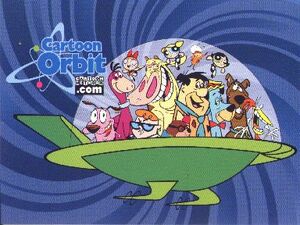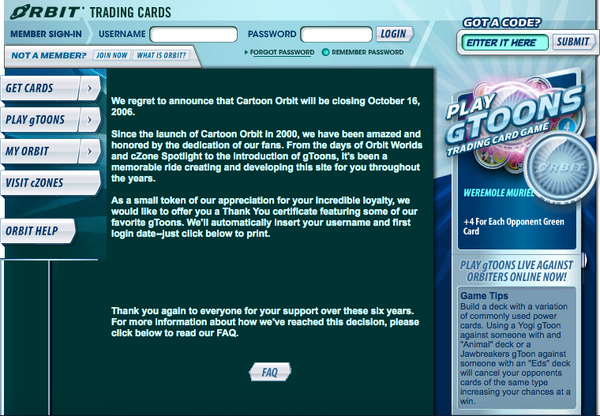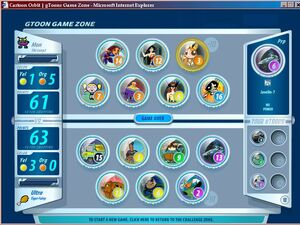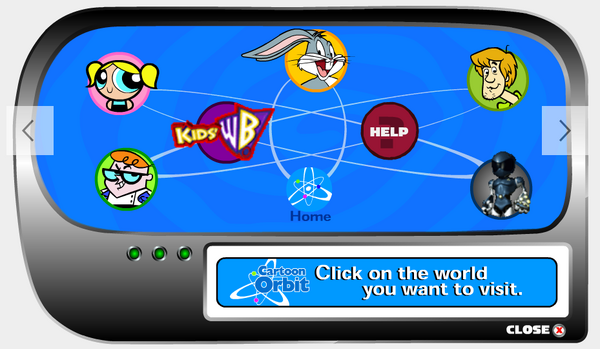Cartoon Orbit was an online gaming network created by Turner Online to promote its shows and partners. Created as an addition to the Cartoon Network website, Cartoon Orbit opened to the public in October 2000. Its main attraction was a system of virtual trading cards called "cToons", which generally featured animation cells from programs broadcast on the network, though advertisement-based cToons were also common. A head-to-head strategy game titled gToons was added to Cartoon Orbit in October 2002.
The site began to suffer from lack of maintenance in 2005 and on October 16, 2006, Cartoon Network shut down Cartoon Orbit, leaving users with a "Thank You" certificate as a token of their appreciation.
History[]
The brainchild of Sam Register, Cartoon Orbit was first built using parts of Communities.com's "Passport" software (not to be confused with the current Communities.com, which is unrelated). This software was a 2D, avatar-based chat server, where members could decorate their own spaces, and it was used extensively in Orbit for displaying and editing cZones. Most of the chat functionality, however, did not become part of the finished product. To comply with the Children's Online Privacy Protection Act, Cartoon Orbit instead had a list of pre-written words and phrases that players could send in a chat box.[1]
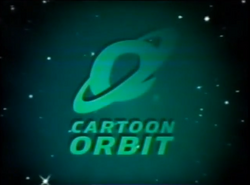
Logo used from 2002 to 2006.
Cartoon Orbit was officially launched in October 2000 as an online community with required registration.[2] Its membership grew 150,000 members strong by mid-December, and that figure increased to over 300,000 by February 2001.[3] Members exceeded 850,000 by October 2001.[1] Shortly after its release, Register expressed a desire to convert Orbit's point-based currency to a cash-based setup, but this never came to fruition.[4] As part of a larger campaign with Cartoon Network, a promotion for the fund-raising program Trick-or-Treat for UNICEF, which entailed exclusive Halloween-themed cToons, was held from October 1 to November 5, 2002.[5]
For the first few years of its existence, the site was updated weekly. However, beginning in mid-2005, it became apparent that Turner Online had stopped maintaining the site. Updates were ceased completely in February 2006, and on August 17, 2006, Cartoon Network removed the navigation for Cartoon Orbit from its main header. The link could only be found on the bottom of the home page.
Starting September 29, 2006, users were no longer able to sign up for and create new Cartoon Orbit accounts. When clicking the "Join Now" button, the user was presented with a "Registration is Closed" page. On October 2, 2006 a notice that Cartoon Orbit would close was posted on the front page.
Cartoon Orbit officially closed in the early morning of October 16, 2006.
Features[]
Players were given points to purchase cToons, from the in-game store, called the "cMart." Players could also receive cToons, gToons, and cRings by entering special redemption codes, trading with other players, or through auctions.
cToons[]
cToons came with a wide range of functionalities. Most were static, but some were animated and/or had sound. Other cToons, when clicked, played mini-games or had special functionality (such as a Dexter's Laboratory-themed cToon that automatically counted down to Albert Einstein's birthday).
Players were given their own gallery spaces, called cZones, to decorate with cToons, cRings, and gToons of their choice. One could further customize their cZone by changing their cZone's background.
cToons ranged from very simple to animated and/or sound capable. Some cToons were part of special sets, and developed their own names. These included:
- Code cToons: cToons that were only available by entering a code, and after a designated amount of time, were no longer redeemable. The codes needed to redeem these cToons could be obtained through Cartoon Network commercials, promotional items, or from sponsor sites. Codes were also revealed during Cartoon Cartoon Fridays.
- Ad cToons: Sponsored advertisement cToons that were typically gained via a code, and some of which would disappear after the promotion ended, be changed to remove the advertisement logo, or replaced with a different cToon altogether.
- Golden cToons: cToons that were gold in color; some of which were very rare.
- Game cToons: cToons that, when placed on a cZone and clicked, opened a miniature flash game. Some of them would give you a "prize" code cToon at the end if you achieved a certain target.
- Checklist cToons: cToons that, when placed on a cZone and clicked, were able to be printed off by the user so they would have a checklist of all the new cToons due to be released that month. New checklist cToons were created from November 2001 to June 2003.
- Sticker cToons: Much like a traditional sticker, most had quotes or quips from the character portrayed. The majority of the sticker cToons were released in 2001.
- Holiday cToons: First released around Christmas in 2001. In 2002 and 2003, inexpensive Holiday presents were created which were meant to be freely given to other players. After Christmas, the present cToons were automatically exchanged for a real cToon.
- Auction Only cToons: cToons that could only be purchased from Orbit Auctions, such as the Hamtaro cToon.
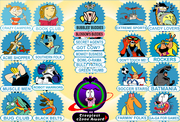
Several cRings
- cRings: connect Orbiters who share the same interests, favorite characters, hobbies, etc. When you see a cRing on someone's cZone, click on it to automatically be taken to another cZone displaying that cRing. cRings usually sell out very quickly, and their rarity makes them extremely valuable cards to collect.
gToons[]
gToons was Cartoon Orbit's collectible card game extension. Launched on October 14, 2002, over 250,000 users had joined after the first month, and over 400,000 users were playing after the first two months.[6] gToons closed along with Cartoon Orbit on October 16, 2006.
In this game, 2 players assembled decks composed of 12 gToons each. Cards represented characters, places, and props from shows broadcast on Cartoon Network, and each card had a color, value, and occasionally a special effect that could modify the value(s) of other card(s). A game of gToons, which typically lasted about three minutes, involved two players strategically using seven gToons at a time to gain the most points by the game's end. Two colors (determined by the "bottom" card of each player's deck) were goal colors: if the two colors were both "neutral" colors (black or silver), the higher total point value won. If there was exactly one non-neutral color (blue, red, yellow, green, purple, etc.) between the goal colors, a player with more cards of the non-neutral color would receive a 15 point bonus to their total before determining victory. If neither color were neutral, a player could win by having more of each color in play than the opponent; otherwise, the higher total value won. Five separate expansion packs containing different goons were released between 2003 and 2006.
Areas[]
- Challenge Zone: An area where players could challenge others to a game of gToons.
- cMart: An area where players could buy cToons and gToons. They could be sorted by show, character, price, type, prop, or set. Most cToons did not stay in the cMart for long and were soon sold out.
- cZone: The part of the Cartoon Orbit site that belonged to the user. A user's cZone could be decorated with their cToons and gToons, like a gallery or sticker book.
- My Collection: An area where users could view their cToons and gToons, which could be sorted into categories by show or by type.
- Showcase cZone: An area where users could view new cToons and updates on Orbit, and also the main Live Trading area.
- Auctions: A standard auction setup which allowed players to put cToons up for sale. The highest bidder at the end of the auction received the cToon, and the seller received the bid points minus a small fee. Auctions were introduced in August 2002.
- cZone Directory: Used to find other people's cZones. There was also a cZone Spotlight (a list of some particularly well-made cZones).
- My Favorites: A section where users could visit someone's cZone and add them to a Buddy List. The Buddy List also allowed a user to see if the person they added was logged in. If they were logged in, they could choose to "follow" the person and go to the section of the website that they were currently located at. The cZone Directory somewhat resembled this.
- Team Orbit: A group of 100 Cartoon Orbit users who were chosen to make suggestions about the game after it was released to the public. Team Orbit only lasted a few months in 2001, and it was replaced by the ideas and comments coming from numerous fan sites.
- ToonFlash Newsletter: A newsletter that Cartoon Orbit periodically sent out to all users via email.
Orbit Worlds[]
Before 2002, there was an interactive area titled "Worlds" on Cartoon Orbit. These "worlds" were based on several fictional locations from the Network's cartoons. They were removed before the transition to Flash in 2002. The "world" pages came complete with a quote or quip from that world's characters, a poll, and links to "Spotlight" cZones.
- Centersphere: This "special" world was the landing page when entering Orbit. From here users could go to the other worlds.
- Townsville: "Formed eons ago by a spectacular collision of sugar, spice and everything nice, Townsville shines in the night sky with a unique pink hue. The surface of Townsville is highly diverse: the younger, lower terrain of the northern hemisphere is full of flowers, whereas the older, higher terrain of the southern hemisphere is often densely populated by squirrels."
- Dexter's Laboratory: "Home to the boy genius himself, Dexter’s Laboratory is chock full o’ Bunsen burners, vials of bubbling green liquid and all sorts of mechanical doohickeys."
- Scooby World: "Accidentally discovered by Shagnacious P. Rogers III, a part-time toongazer and full-time resident of Coolsville, the atmosphere of Scooby World is rich in spookiness. Notable for natural resources such as Scooby Snacks and Malt Shops, visitors to Scooby World are often seen roving the landscape in colorful utility vehicles known as Mystery Machines."
- Bedrock: "The distinctly primitive Bedrock, Cartoon Orbit's earliest known formation, hovers a mere 36 million miles from Centersphere. Despite its boulder-strewn surface, which yields sparse vegetation, Bedrock boasts all the luxuries and locations of modern prehistoric life, from the Polarock camera to the masto-vacuum. In other words: Don't take it for granite."
- Cartoon Networld: "The story of Cartoon Networld is the story of cartoon stars who migrate here daily from the television screens of a grateful populace. Cartoon Networld is a first-rate retreat with many pleasing amenities, a sunshine playground for the top cartoon stars. Warning: the atmosphere of Cartoon Networld may alter the central humor system of visitors who encounter its numerous laugh-inducing environments."
- Kids WB Backlot: This world was added after the removal of Bedrock.
- Toonami: This world was added after the removal of Bedrock.
References[]
- ↑ 1.0 1.1 Connell, Mike (October 1, 2001). "Kids Sites Carefully Negotiate the Post-COPPA Web Environment". =Kidscreen.com. http://kidscreen.com/2001/10/01/netsafety-20011001/. Retrieved on May 22, 2015.
- ↑ "CartoonNetwork.com to Launch Cartoon Orbit". Timewarner.com. September 12, 2000. http://www.timewarner.com/newsroom/press-releases/2000/09/12/cartoonnetworkcom-to-launch-cartoon-orbit. Retrieved on May 22, 2015.
- ↑ "Cartoon Orbit Members Top 300,000". Timewarner.com. February 21, 2001. http://www.timewarner.com/newsroom/press-releases/2001/02/21/cartoon-orbit-members-top-300000. Retrieved on May 22, 2015.
- ↑ Longworth, Jocelyn (November 1, 2000). "Cartoon's Collectible Hooks Drive Kid Interest in Powerpuff Vid Games and New On-line Hub". Kidscreen.com. http://kidscreen.com/2000/11/01/30314-20001101/. Retrieved on May 22, 2015.
- ↑ "UNICEF and Cartoon Network Launch First-Time Partnership for Annual Trick-or-Treat for UNICEF". Timewarner.com. August 28, 2002. http://www.timewarner.com/newsroom/press-releases/2002/08/28/unicef-and-cartoon-network-launch-first-time-partnership-for. Retrieved on May 22, 2015.
- ↑ Longworth, Jocelyn (January 8, 2003). "Gaming Takes Virtual Trading Cards to the Next Promo Level". =Kidscreen.com. http://kidscreen.com/2003/01/08/cards-20030108/. Retrieved on May 22, 2015.

